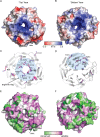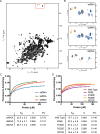The structure of the RbBP5 β-propeller domain reveals a surface with potential nucleic acid binding sites
- PMID: 29897600
- PMCID: PMC6283417
- DOI: 10.1093/nar/gky199
The structure of the RbBP5 β-propeller domain reveals a surface with potential nucleic acid binding sites
Abstract
The multi-protein complex WRAD, formed by WDR5, RbBP5, Ash2L and Dpy30, binds to the MLL SET domain to stabilize the catalytically active conformation required for histone H3K4 methylation. In addition, the WRAD complex contributes to the targeting of the activated complex to specific sites on chromatin. RbBP5 is central to MLL catalytic activation, by making critical contacts with the other members of the complex. Interestingly its only major structural domain, a canonical WD40 repeat β-propeller, is not implicated in this function. Here, we present the structure of the RbBP5 β-propeller domain revealing a distinct, feature rich surface, dominated by clusters of Arginine residues. Our nuclear magnetic resonance binding data supports the hypothesis that in addition to the role of RbBP5 in catalytic activation, its β-propeller domain is a platform for the recruitment of the MLL complexes to chromatin targets through its direct interaction with nucleic acids.
Figures





Similar articles
-
The internal interaction in RBBP5 regulates assembly and activity of MLL1 methyltransferase complex.Nucleic Acids Res. 2019 Nov 4;47(19):10426-10438. doi: 10.1093/nar/gkz819. Nucleic Acids Res. 2019. PMID: 31544921 Free PMC article.
-
The MLL1 trimeric catalytic complex is a dynamic conformational ensemble stabilized by multiple weak interactions.Nucleic Acids Res. 2019 Sep 26;47(17):9433-9447. doi: 10.1093/nar/gkz697. Nucleic Acids Res. 2019. PMID: 31400120 Free PMC article.
-
Diverse roles of WDR5-RbBP5-ASH2L-DPY30 (WRAD) complex in the functions of the SET1 histone methyltransferase family.J Biosci. 2017 Mar;42(1):155-159. doi: 10.1007/s12038-017-9666-9. J Biosci. 2017. PMID: 28229975 Review.
-
An Ash2L/RbBP5 heterodimer stimulates the MLL1 methyltransferase activity through coordinated substrate interactions with the MLL1 SET domain.PLoS One. 2010 Nov 23;5(11):e14102. doi: 10.1371/journal.pone.0014102. PLoS One. 2010. PMID: 21124902 Free PMC article.
-
WRAD: enabler of the SET1-family of H3K4 methyltransferases.Brief Funct Genomics. 2012 May;11(3):217-26. doi: 10.1093/bfgp/els017. Epub 2012 May 30. Brief Funct Genomics. 2012. PMID: 22652693 Free PMC article. Review.
Cited by
-
The internal interaction in RBBP5 regulates assembly and activity of MLL1 methyltransferase complex.Nucleic Acids Res. 2019 Nov 4;47(19):10426-10438. doi: 10.1093/nar/gkz819. Nucleic Acids Res. 2019. PMID: 31544921 Free PMC article.
-
The role of DNA methylation in human pancreatic neuroendocrine tumours.Endocr Oncol. 2023 Apr 17;3(1):e230003. doi: 10.1530/EO-23-0003. eCollection 2023 Jan 1. Endocr Oncol. 2023. PMID: 37434653 Free PMC article. Review.
-
The MLL1 trimeric catalytic complex is a dynamic conformational ensemble stabilized by multiple weak interactions.Nucleic Acids Res. 2019 Sep 26;47(17):9433-9447. doi: 10.1093/nar/gkz697. Nucleic Acids Res. 2019. PMID: 31400120 Free PMC article.
-
ASH2L is involved in promotion of endometrial cancer progression via upregulation of PAX2 transcription.Cancer Sci. 2020 Jun;111(6):2062-2077. doi: 10.1111/cas.14413. Epub 2020 May 23. Cancer Sci. 2020. PMID: 32279431 Free PMC article.
-
Structural Paradigms in the Recognition of the Nucleosome Core Particle by Histone Lysine Methyltransferases.Front Cell Dev Biol. 2020 Jul 31;8:600. doi: 10.3389/fcell.2020.00600. eCollection 2020. Front Cell Dev Biol. 2020. PMID: 32850785 Free PMC article. Review.
References
-
- Berger S.L. The complex language of chromatin regulation during transcription. Nature. 2007; 447:407–412. - PubMed
-
- Kouzarides T. Chromatin modifications and their function. Cell. 2007; 128:693–705. - PubMed
-
- Schuettengruber B., Chourrout D., Vervoort M., Leblanc B., Cavalli G.. Genome regulation by polycomb and trithorax proteins. Cell. 2007; 128:735–745. - PubMed
-
- Ringrose L., Paro R.. Epigenetic regulation of cellular memory by the Polycomb and Trithorax group proteins. Annu. Rev. Genet. 2004; 38:413–443. - PubMed
Publication types
MeSH terms
Substances
Grants and funding
LinkOut - more resources
Full Text Sources
Other Literature Sources
Molecular Biology Databases

